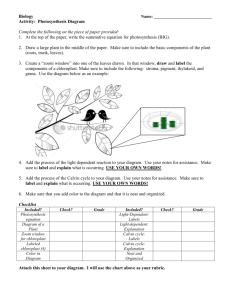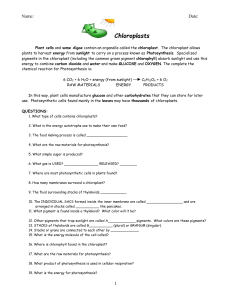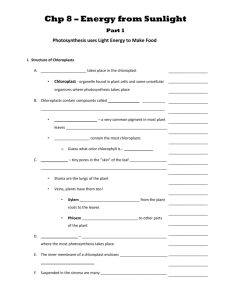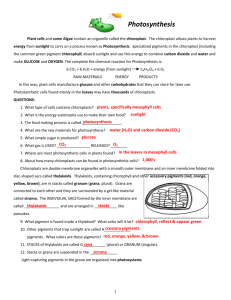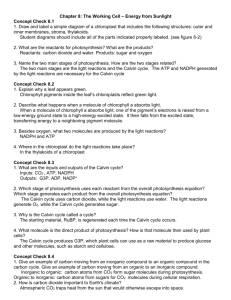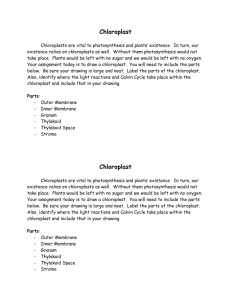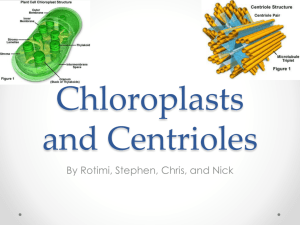Chp8 - Chloroplast WKS
advertisement
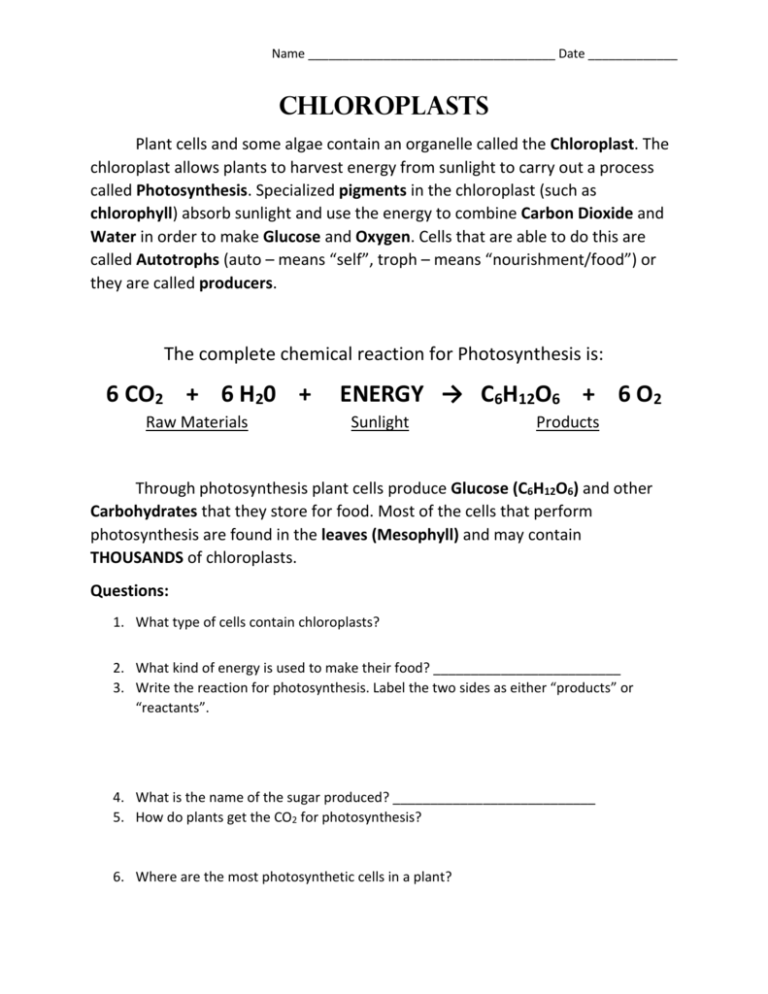
Name ____________________________________ Date _____________ Chloroplasts Plant cells and some algae contain an organelle called the Chloroplast. The chloroplast allows plants to harvest energy from sunlight to carry out a process called Photosynthesis. Specialized pigments in the chloroplast (such as chlorophyll) absorb sunlight and use the energy to combine Carbon Dioxide and Water in order to make Glucose and Oxygen. Cells that are able to do this are called Autotrophs (auto – means “self”, troph – means “nourishment/food”) or they are called producers. The complete chemical reaction for Photosynthesis is: 6 CO2 + 6 H20 + Raw Materials ENERGY → C6H12O6 + 6 O2 Sunlight Products Through photosynthesis plant cells produce Glucose (C6H12O6) and other Carbohydrates that they store for food. Most of the cells that perform photosynthesis are found in the leaves (Mesophyll) and may contain THOUSANDS of chloroplasts. Questions: 1. What type of cells contain chloroplasts? 2. What kind of energy is used to make their food? _________________________ 3. Write the reaction for photosynthesis. Label the two sides as either “products” or “reactants”. 4. What is the name of the sugar produced? ___________________________ 5. How do plants get the CO2 for photosynthesis? 6. Where are the most photosynthetic cells in a plant? Name ____________________________________ Date _____________ Figure 1 – Chloroplast Chloroplasts have a double membrane and the outer membrane is smooth. On the inside there a membranes folded into disk-shaped sacs called Thylakoids. Color and label the outer membrane and the inner membrane. Thylakoids contain the pigment molecules including chlorophyll but they also have accessory pigments that are red, orange, yellow and brown. When you stack thylakoids on top of each other they are called a Granum (Grana, plural). Color and label the grana. Grana are connected to each other by structures called Lamellae that look like little bridges between them. Last, all around the grana inside the chloroplast is a liquid called the Stroma. Color and label the lamellae and the stroma. Questions: 7. How many membranes surround a chloroplast? __________ 8. The INDIVIDUAL disks inside the chloroplast are called _____________________ and they are stacked together to form ____________________. 9. What are the two types of pigments found in the chloroplast? 10. Where does the process of photosynthesis actually take place? 11. How many chloroplasts can be found inside plant cells? Name ____________________________________ Date _____________ Light Reactions and Calvin Cycle Photosynthesis happens in two main steps: the Light reactions and the Calvin Cycle. The light reaction captures the energy from sunlight in the thylakoids and splits apart a water molecule. Using the light energy ATP and NADPH are produced in the light reaction. As a waste product, oxygen is produced and released into the atmosphere (important for you). The Calvin cycle uses the ATP and NADPH to make CO2 into a glucose molecule. The final product of the Calvin cycle is a single sugar molecule. Once the ATP and NADPH are used up they turn into ADP + P and NADP+ and return to the light reactions. Use the information above and your notes to draw a diagram (and label!) of the Light reaction and Calvin Cycle. Questions: 12. What are the products of the Light reactions? Which one is particularly important for you? 13. What are the products of the Calvin cycle? Where does glucose go afterwards?
